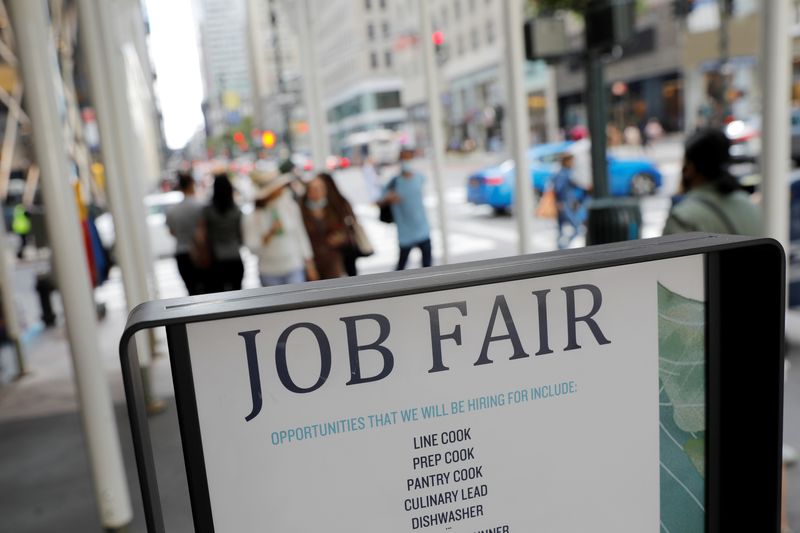By Lucia Mutikani
WASHINGTON (Reuters) - The number of Americans filing new claims for unemployment benefits increased moderately last week and data for the prior two weeks was revised sharply lower as fraudulent applications from Massachusetts were stripped out, indicating persistent labor market strength.
The report from the Labor Department on Thursday, which also showed fewer people collecting unemployment checks in mid-May, suggested that the economy was enjoying another month of strong employment gains and a lower jobless rate.
The government is scheduled to publish its closely watched employment report for May next Friday. Some economists said labor market resilience raised the risk that the Federal Reserve could raise interest rates again in June. Minutes of the Fed's May 2-3 policy meeting published on Wednesday showed U.S. central bank officials "generally agreed" that the need for further rate hikes "had become less certain."
"The worrisome trend of more layoffs just got completely revised away where the labor market isn't loosening up as much as Fed officials and markets had thought," said Christopher Rupkey, chief economist at FWDBONDS in New York. "The Fed looks further behind the inflation-fighting curve than ever with the labor market tightness refusing to budge."
Initial claims for state unemployment benefits increased 4,000 to a seasonally adjusted 229,000 for the week ended May 20. Data for the prior week was revised to show 17,000 fewer applications received than previously reported.
Claims for the week ending May 6 were revised down by 33,000, leaving filings substantially lower during the period that the government surveyed businesses for the nonfarm payrolls portion of May's employment report.
The economy added 253,000 jobs in April. Economists polled by Reuters had forecast 245,000 claims for the latest week.
Massachusetts' Department of Unemployment Assistance said this month it was "experiencing an increase in fraudulent claim activities."
Unadjusted claims for Massachusetts fell 2,190 last week.
The labor market has slowed only marginally despite 500 basis points worth of interest rate increases from the Fed since March 2022, when it embarked on its fastest monetary policy tightening campaign since the 1980s to tame inflation.
There were 1.6 job openings for every unemployed person in March, well above the 1.0-1.2 range that is consistent with a jobs market that is not generating too much inflation.
Employers have been hoarding workers after experiencing difficulties finding labor in the wake of the COVID-19 pandemic.
Economists expected layoffs to increase as the effects of the punitive rate hikes spread through the economy and tightening financial conditions make it harder for small businesses to access credit.
That sentiment is shared by policymakers. The Fed meeting minutes showed that while "participants noted that the labor market remained very tight," they "anticipated that employment growth would likely slow further, reflecting a moderation in aggregate demand coming partly from tighter credit conditions."
The number of people receiving benefits after an initial week of aid, a proxy for hiring, fell 5,000 to 1.794 million during the week ending May 13, the claims report showed. The so-called continuing claims covered the period during which the government surveyed households for May's unemployment rate.
Continuing claims dropped between the April and May survey weeks. The unemployment rate fell back to a 53-year low of 3.4% in April. The low claims align with recent data on retail sales, factory production and business activity that have suggested the economy regained speed at the start of the second quarter.
U.S. stocks were trading higher. The dollar rose against a basket of currencies. U.S. Treasury prices fell.
ON SHAKY GROUND
Nevertheless, the economy is on shaky ground amid declining profits, which could hamper hiring and investment down the road. A stalemate over raising the government's borrowing cap also poses a risk to the economy.
Gross domestic product increased at a 1.3% annualized rate in the first quarter, the Commerce Department said in its second GDP estimate on Thursday, revised up from the 1.1% pace reported last month. The economy grew at a 2.6% pace in the fourth quarter. There were upgrades to inventory investment, state and local government spending, business investment as well as exports. Investment in homebuilding was revised lower.
After-tax profits without inventory valuation and capital consumption adjustment, which correspond to S&P 500 profits, decreased at a 2.1% rate, the third straight quarterly drop.
They were down 6.0% on a year-on-year basis, the largest decline since the second quarter of 2020, a sign that companies were struggling to pass on higher costs to customers.
With profits falling, economic output contracted at a 2.3% pace in the first quarter when measured from the income side.
Gross domestic income (GDI) declined at a 3.3% rate in the fourth quarter, revised down from the previously reported 1.1% pace of contraction. That reflected downward revisions to fourth-quarter wages and salaries growth.
In principle, GDP and GDI should be equal, but in practice differ as they are estimated using different and largely independent source data.
The gap between GDI and GDP, also known as the statistical discrepancy, widened sharply in 2021, catching the attention of policymakers. The statistical discrepancy in 2021 subsequently narrowed when the government carried out its annual revision of the data in 2022, with GDP revised higher and GDI lower.
"This weakness in GDI suggests that real GDP growth in recent quarters may be revised lower," said Jay Bryson, chief economist at Wells Fargo (NYSE:WFC) in Charlotte, North Carolina. "Although one side of the economic accounts may be contracting, the U.S. economy is probably not in recession at present."

The average of GDP and GDI, also referred to as gross domestic output and considered a better measure of economic activity, fell at a 0.5% rate last quarter after slipping at a 0.4% pace in the fourth quarter.
"The true health of the economy likely lies somewhere in-between as neither measure is perfect," said Ryan Sweet, chief economist at Oxford Economics in West Chester, Pennsylvania.